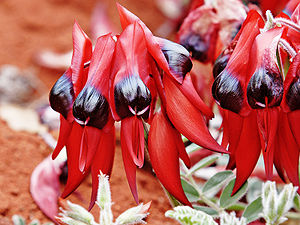The South Australia Portal
South Australia (commonly abbreviated as SA) is a state in the southern central part of Australia. With a total land area of 984,321 square kilometres (380,048 sq mi), it is the fourth-largest of Australia's states and territories by area, which includes some of the most arid parts of the continent, and with 1.8 million people it is the fifth-largest of the states and territories by population. This population is the second-most highly centralised in the nation after Western Australia, with more than 77% of South Australians living in the capital Adelaide or its environs. Other population centres in the state are relatively small; Mount Gambier, the second-largest centre, has a population of 26,878. South Australia shares borders with all the other mainland states. It is bordered to the west by Western Australia, to the north by the Northern Territory, to the north-east by Queensland, to the east by New South Wales, to the south-east by Victoria, and to the south by the Great Australian Bight. The state comprises less than 8% of the Australian population and ranks fifth in population among the six states and two territories. The majority of its people reside in greater Metropolitan Adelaide. Most of the remainder are settled in fertile areas along the south-eastern coast and River Murray. The state's colonial origins are unique in Australia as a freely settled, planned British province, rather than as a convict settlement. Colonial government commenced on 28 December 1836, when the members of the council were sworn in near the Old Gum Tree. As with the rest of the continent, the region has a long history of human occupation by numerous tribes and languages. The South Australian Company established a temporary settlement at Kingscote, Kangaroo Island, on 26 July 1836, five months before Adelaide was founded. The guiding principle behind settlement was that of systematic colonisation, a theory espoused by Edward Gibbon Wakefield that was later employed by the New Zealand Company. The goal was to establish the province as a centre of civilisation for free immigrants, promising civil liberties and religious tolerance. Although its history has been marked by periods of economic hardship, South Australia has remained politically innovative and culturally vibrant. Today, it is known for its fine wine and numerous cultural festivals. The state's economy is dominated by the agricultural, manufacturing and mining industries. (Full article...) Selected article -
Source: australianfootball.com (Full article...)
Rules for classification: 1) points; 2) percentage; 3) number of points for. (P) Premiers Selected Picture - Sturt's Desert Pea is an Australian plant in the genus Swainsona. One of Australia's best-known wildflowers, it is known for its distinctive blood-red leaf-like flowers, each with a bulbous black centre, or "boss". It is native to the arid regions of central and north-western Australia, and its range extends into all mainland Australian states with the exception of Victoria. It is the floral emblem of South Australia. General imagesThe following are images from various South Australia-related articles on Wikipedia.
Did You Know... -
CategoriesRelated PortalsWikiProjectsMajor TopicsGeography – Adelaide Hills • Adelaide Plains • Barossa Valley • Clare Valley • Coonawarra • Eyre Peninsula • Fleurieu Peninsula • Flinders Ranges • Kangaroo Island • Limestone Coast • Mid North • Nullarbor Plain • Riverland • Yorke Peninsula History – Kaurna Indigenous people • European settlement • History of Adelaide • Proclamation Day • Australian Overland Telegraph Line • Timeline of South Australian history Towns and Cities – Adelaide • Coober Pedy • Mount Gambier • Murray Bridge| Port Augusta • Port Lincoln • Port Pirie • Victor Harbor • Whyalla Economy and Politics – Premiers • Governors • Parliament • House of Assembly • Electoral districts • Legislative Council • State elections Culture – Croweater • Pie floater • Wine • The Advertiser • Adelaide Festival Centre • Adelaide Entertainment Centre • WOMADelaide • Adelaide Fringe • Elder Park • The Crows • The Power • The Reds • Redbacks • Hindmarsh Stadium • AAMI Stadium • Rundle Mall People – Kaurna Indigenous people • Matthew Flinders • William Light • Charles Sturt • Edward Gibbon Wakefield • John Hindmarsh • George Gawler • Playford family • Don Dunstan More portalsThings you can doHere are some tasks you can do to help with WikiProject Adelaide:
 Associated WikimediaThe following Wikimedia Foundation sister projects provide more on this subject:
Discover Wikipedia using portals | |||||||||||||||||||||||||||||||||||||||||||||||||||||||||||||||||||||||||||||||||||||||||||||||||||||||||||||||||||























































